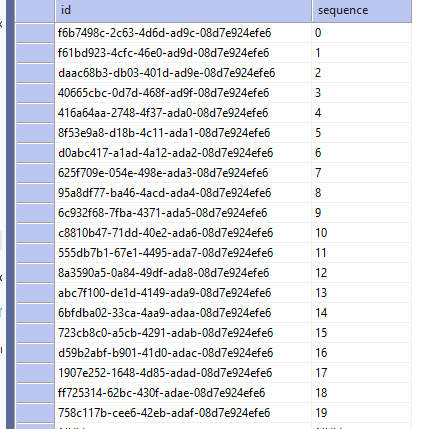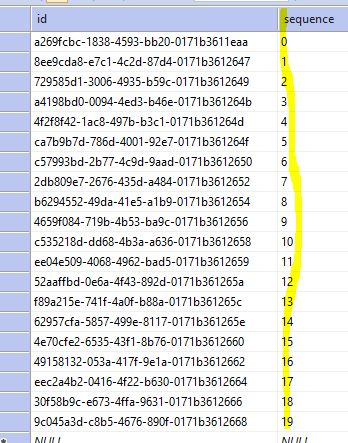Using a non sequential GUID in either a clustered or non clustered index is not ideal from a performance point of view as non sequential GUIDs are not ever-increasing (like an identity int) so get inserted into the middle of the index rather than the end resulting in increased logical fragmentation and decreased performance.
If you really can’t switch from a GUID to an identity int (to save space and fragmentation) and you must use a GUID in an index, to mitigate against the performance problems ensure it is sequential and ever-increasing. SQL Server allows you to do this by setting a default constraint on uniqueidentifier columns which calls the NEWSEQUENTIALID() method. This method creates a GUID that is greater than any GUID previously generated by it on a specified computer since Windows was started. The problem with this method however is it is created on the DB side and won’t be useful if you need to pass in a GUID from the client side.
There are a number of options which can be used to generate sequential GUIDs in C# which are compatible with SQL Servers GUID/UUID sorting mechanism, I’ll cover three of them in this post.
Options for generating SQL Server compatible sequential GUIDs
- SequentialGuidValueGenerator which is part of Entity Framework core.
Note at the time of writing the documentation for this is incorrect. It does not generate sequential Guids using the same algorithim as NEWSEQUENTIALID(), however it does indeed generate sequential GUIDs which are sortable with respect to SQL Servers GUID sorting approach. Looking at the source of the method we can see this method calls the regular Guid.NewGuid() and performs byte shuffling to make it optimised for SQL Server. Usage is simple and of course you don’t need to be actually using EF to reference the assembly and just use the function. The generated GUIDs correctly sort in SQL Server.

- UuidCreateSequential with byte shuffling applied.
NEWSEQUENTIALID() is a wrapper over the Windows UuidCreateSequential function with some byte shuffling applied. We can therefore call this function by importing the relevant .dll and rearrange the bytes in the same way as SQL Server does to get sequential GUIDs in C#. The link above from StackOverflow has all the implementation details. Looking at 20 GUIDs created with this approach we can see they are much more uniform than the Sequential GUID algorithm from EF covered above.
Depending on your scenario a number of problems with this approach may limit its feasiblity:
1 – Requires DLLImport which may not be allowed/desired and might have permissions issues.
2- Not cross platform, this is a windows dll, so if your deploying your .net core app to Linux this isn’t a runner.
3 – If your windows server restarts your GUIDs may start from a lower range thus causing index fragmentation.
4 – Can’t be used in cluster environment where mutiple machines write to same DB as GUIDs generated will all be out of synch with each other thus causing index fragmentation. - COMB GUID.
The COMB GUID approach was first described by Jimmy Nilsson and involves replacing the portion of a normal GUID that is sorted first with a date/time value. This guarantees (within the precision of the system clock) that values will be sequential, even when the code runs on different machines. There are lots of examples of COMB GUIDs in C# online but I like RT.Comb which is a library available on Nuget. Below you can see how its used in its basic configuration. And we can see the GUIDs it creates are sorted correctly in SQL Server…
And we can see the GUIDs it creates are sorted correctly in SQL Server…

but wait… actually they are not sorted correctly. This is because the timestamp is generated using DateTime.UtcNow which has precision of 1/300th of a second meaning that if you quickly generate a lot of COMB Guids like above there is a chance you’ll create two with the same timestamp value. This won’t result in collisions as the non timestamp bits will take care of that but it means COMBs with the same timestamp are not guaranteed to be sorted correctly for insertion into the DB.
Therefore if you’re inserting records faster than the precision offered by DateTime.UtcNow (very possible) these inserts will cause index fragmentation. Avoiding index fragmentation is the whole purpose of using sequential GUIDs in the first place so we need a solution to this if COMBs are to be viable compared to other approaches.
Thankfully a solution is provided by RT.Comb itself and is part of the reason I like to use this library rather than just some of the code for creating COMBs available on StackOverflow or other places online. RT.Comb has a timestamp provider called UtcNoRepeatTimestampProvider which ensures that the current timestamp is at least Xms (4ms is the default, but this can be changed) greater than the previous one and increments the current one by Xms if it is not. The library documentation gives the following table of what timestamp UtcNoRepeatTimestampProvider (RHS) will provide compared to the original DateTime.UtcNow (LHS) timestamp.
02:08:50.613 02:08:50.613
02:08:50.613 02:08:50.617
02:08:50.613 02:08:50.621
02:08:50.617 02:08:50.625
02:08:50.617 02:08:50.629
02:08:50.617 02:08:50.632
Using UtcNoRepeatTimestampProvider is simple and results in GUIDs which are correctly sorted in SQL Server as shown below.


Which Sequential GUID approach to use?
Of course there are many other solutions on the web which you can choose. All three discussed above are super fast. On my machine I did 100K iterations in at most 101 ms so this wouldn’t influence me either way. Given the potential problems outlined with the dll import approach above I’d avoid this unless there were not viable alternatives, which there are.
There’s not much to choose between the other two. If your using EF Core to update your DB then you’ll have Sequential
Note Sequential GUIDs by their nature are guessable so don’t use these in a security sensitive context.
Need Help with Your C# Projects?
We offer expert support and development services for projects of any size. Contact us for a free consultation and see how we can help you succeed.
CONTACT US NOW